- Scientific name: Crotalus horridus
- Species of Greatest Conservation Need (MA State Wildlife Action Plan)
- Endangered (MA Endangered Species Act)
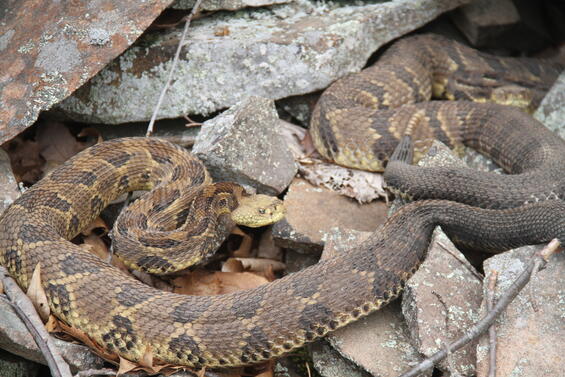
Adult Massachusetts rattlesnakes basking near a den.
Description
The timber rattlesnake (Crotalus horridus) is one of Massachusetts' most iconic species of remote, mountainous, and rocky woodlands. They are extremely rare, and (like copperheads, the only other venomous species in Massachusetts) they are seldom encountered accidentally. Like copperheads, rattlesnakes are relatively large, heavy-bodied snakes in the viper family (Viperidae). Adults typically range from 90–150 cm (36 to 60 in) long, and neonates or newborns are 20–40 cm (8 to 16 in) long. Males are larger than females: Massachusetts males average about 1 kg (2.2 lb), and females average 0.6 kg (1.3 lb).
Like all pit vipers in North America, timber rattlesnakes have triangular heads with a distinct narrowing behind the head. Rattlesnakes also have a heat-sensing pit between the eye and nostril. Their prominent fangs are hinged and can fold back when the mouth is closed. It’s usually not possible to differentiate the sexes from a distance, although males are often noticeably larger and have longer tails than females with more subcaudal scales. With some practice, the two sexes can be told apart by the trained eye by gestalt.
Color patterns in Massachusetts timber rattlesnakes are variable: some individuals are almost entirely black, while others are yellowish with black, brown, or rust-colored blotches. These blotches are often separated by darker crossbands on the back and sides. They can be distinguished from other North American rattlesnakes by their lack of stripes or bands on the head and face, or by their solid black tail. Perhaps the most distinctive feature of the timber rattlesnake (and all rattlesnakes) is the rattle on its tail. A rattlesnake’s rattle is made up of interlocking segments of keratin (the same material that makes up human fingernails). When the snake vibrates its rattle, it produces a buzzing sound to warn potential predators (including humans). A new rattle segment is added to the base of the rattle each time the rattlesnake sheds its skin, which can happen several times a year. Snakes often lose segments of their rattle, however (or even the entire rattle). As a result, the number of rattle segments is not an indicator of a snake's age, although younger snakes will retain a distinctive natal “button” at the end of their rattles that is different from the later segments.
Like copperheads, timber rattlesnakes have keeled scales, meaning a raised ridge runs down the center of each scale. This gives the snake a rough appearance compared to snakes with smooth scales (such as the North American racer).
Similar Species
Timber rattlesnakes are seldom mistaken for other snake species in Massachusetts, but other common, harmless species are very frequently mistaken for timber rattlesnakes.
Dark or banded snakes:
Four Massachusetts snakes are sometimes confused for timber rattlesnakes because of their dark coloration, large size, or dark blotches, saddles, or bands along their backs: the northern watersnake, the milksnake, the hog-nose snake, and the North American racer. However, their underside markings are distinct.
Eastern milksnakes sometimes have distinctive bands that are similar to the coloration found on a rattlesnake, but the markings are against a lighter background. The milksnake’s pupils are round, and not vertical like a rattlesnake’s. Milksnakes also have a black-and- white checkered pattern on their ventral surface. Milksnakes will “buzz” their tails in leaf litter when threatened.
Northern watersnakes can also be boldly patterned and aggressive. They sometimes have distinctive brownish bands on their back, but watersnakes have a narrow head that is not triangular in shape. Also, watersnakes are less commonly found in upland, rocky, dry habitats where rattlesnakes are most common (but the two species do co-occur at several sites in Massachusetts)
Eastern hog-nosed snakes are sometimes brownish to gray and have similar coloration to a dark timber rattlesnake, but they have a uniformly wide head with an upturned snout. Hog-nosed snakes are very rare in upland rocky habitats in Massachusetts, being more common in glacial outwash and sandy habitats.
North American racers are a glossy black color and have no noticeable pattern as a large adult. Racers also have a whitish chin and smooth or “unkeeled” scales. Like the milksnake, racer will buzz its tail in leaf litter when startled.
Copperheads are the only other pit viper species in Massachusetts, and the only other species to have a vertical pupil like the timber rattlesnake. Copperheads are generally more reddish-brown with a distinctive pattern of reddish hourglasses along their body. Although copperheads have facial pits like rattlesnakes, their heads are narrower and less triangular.
Life cycle and behavior

Timber rattlesnakes (like all snakes) are cold-blooded or ectothermic, which means that individual snakes regulate their body temperature by changing their position in the environment. To warm up, rattlesnakes bask in the sun, often concealed by logs or branches. When they become too hot, individual rattlesnakes will seek damp areas, cool crevices, shady understory areas, or below-ground shelter in talus.
Like other vipers in the family Viperidae, rattlesnakes have heat-sensing pits between their nostril and their eye, which detect infrared heat from warm-blooded prey like small birds and mammals. Rattlesnakes also can perceive vibrations in the ground, aiding in both prey detection and predator avoidance. Like copperheads and other vipers, rattlesnakes have two hinged fangs in their upper jaw at the front of their mouth that inject venom. In Massachusetts, rattlesnakes are generally active from April to October; they overwinter in rocky talus from November through March. However, they can emerge on warm days during the shoulder seasons.
In a typical year, rattlesnakes emerge from hibernation by mid-April to bask on ledges and in sunlit areas of deciduous forests near their den site. Mating can occur in either spring or autumn. By late April or May in a typical year, rattlesnakes disperse from the den area toward upland foraging and gestation sites. Gravid female rattlesnakes will gestate their young in a sheltered, warm locations that can be close to or more than a kilometer (0.6 mi) away from the den. Individual snakes return to their dens between early September and late October for brumation (overwintering).
Like copperheads, timber rattlesnakes are ovoviviparous, meaning they give birth to live young. Females give birth to ~5–9 young between late August and late-September. The newborns have venom, fangs, and a single rattle segment called a "button”. Newborn rattlesnakes may follow scent trails left by their mother to locate the winter den. In northern latitudes, females may reproduce only every 2–3 years due to the energy demands of gestation and the limited foraging opportunities after giving birth. Males can reach sexual maturity around age 4, while wild females probably mature around 7 years old. The maximum lifespan of a timber rattlesnake in Massachusetts is probably greater than 20 years.
Timber rattlesnakes primarily feed on rodents and birds, but they may also consume insects and amphibians. Rattlesnakes are “ambush predators”, lying in wait for prey to come within striking distance. They use a combination of sight, scent, and heat-sensing to locate prey. After striking, they track the envenomated animal using their sense of smell. Rattlesnakes hunt mainly during the day in spring and autumn but become more nocturnal in summer when prey is more active.
Timber rattlesnakes are not aggressive and avoid interactions with people at all costs. Their venom is primarily to subdue prey, not for defense. Rattlesnakes will only strike if they feel threatened or cornered. Rattlesnakes are shy and reclusive animals by nature that prefer to remain undisturbed.
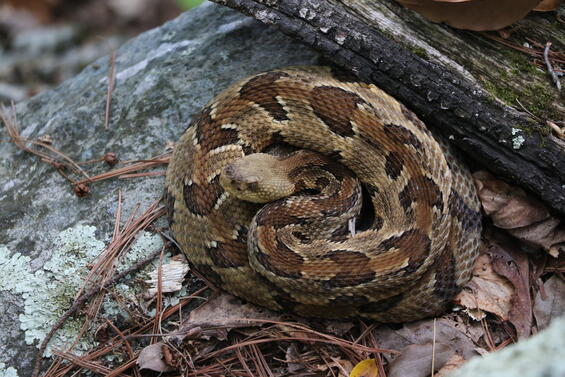
Massachusetts timber rattlesnake with brownish coloration.
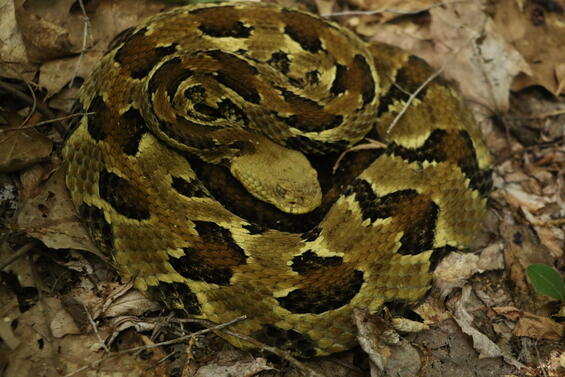
Massachusetts timber rattlesnake with yellow coloration.
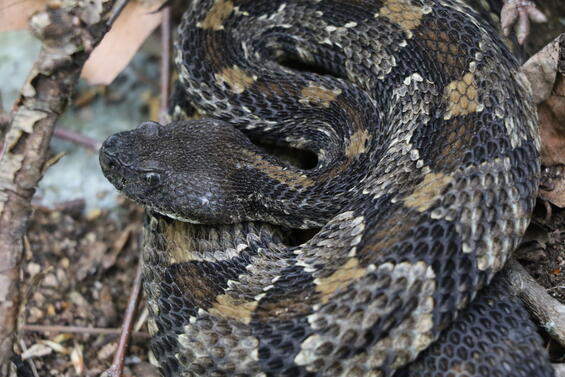
Massachusetts timber rattlesnake with dark or black coloration.
Distribution and abundance
Historically, the timber rattlesnake was widespread throughout eastern North America. However, it has declined significantly in the northeastern United States, especially New England and the upper Midwest. For example, the timber rattlesnake is now extirpated from Maine and Rhode Island. Overall, this decline has resulted in small, isolated populations that are vulnerable to environmental and genetic threats.
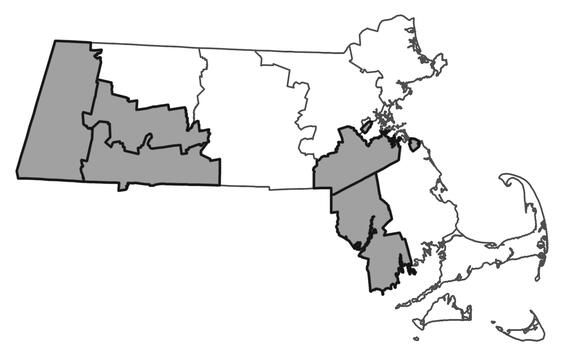
Distribution in Massachusetts.
1999-2024
Based on records in the Natural Heritage Database.
Habitat
Timber rattlesnakes in Massachusetts inhabit mountainous areas of deciduous forests, although within these areas they can be found in a wide range of natural and anthropogenic habitats. Massachusetts rattlesnakes clearly favor rocky terrain where bedrock is exposed at the surface (as opposed to areas of deep till or outwash). Some rattlesnake populations are associated with traprock (basalt) ledges with extensive rockslides and talus provide denning and basking sites, but populations are also known from areas of other intrusive volcanic rocks or the highly deformed metamorphic rocks of the western ridges. Like copperheads, timber rattlesnakes will forage and thermoregulate in wetland habitats. Individual rattlesnakes select favorable microclimates within their rocky and mountainous habitats: south-, southeast-, and southwest-facing slopes offer basking opportunities in spring and fall. Rattlesnakes—like copperheads—favor heterogeneous landscapes that include a mix of deciduous trees, trailing vines like Virginia creeper and poison ivy, ericaceous scrub, eastern red cedar, white pine, eastern hemlock, and grassy meadows. Further, rattlesnake habitat typically supports sufficient prey populations (small mammals, amphibians, insects). Timber rattlesnakes overwinter in rocky underground dens in remote areas of talus and bedrock. Rattlesnake dens are often situated near exfoliating cliffs. During the active season, rattlesnakes utilize a variety of habitats, including basking sites in open clearings within rocky terrain, used for thermoregulation. Rattlesnakes may be found near wetlands, wooded swamps, marshes, lakes, reservoirs, fields, meadows, wet woodlands, and quarries while hunting. Rattlesnakes utilize similar rocky areas and varied forested landscapes as copperheads and are occasionally found together in Massachusetts.
Healthy habitats are vital for supporting native wildlife and plants. Explore habitats and learn about conservation and restoration in Massachusetts.
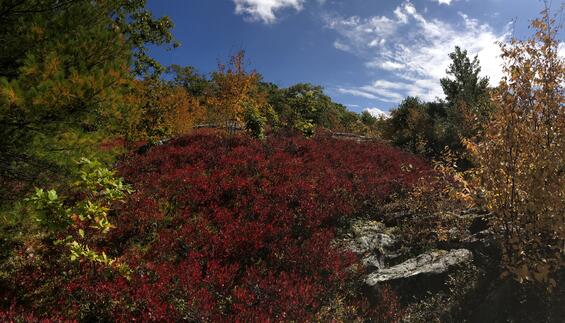
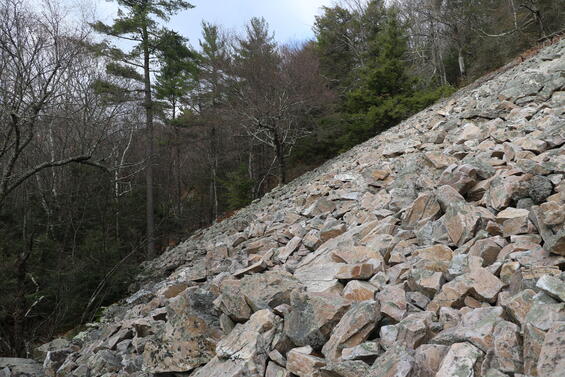
Historic rattlesnake habitat in western Massachusetts.
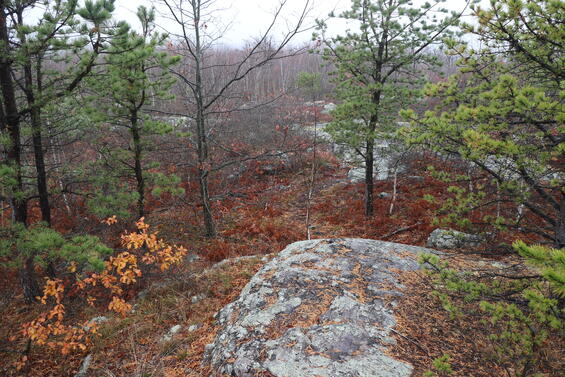
Historic rattlesnake habitat in Lynn Woods, Essex County, Massachusetts.
Threats
The timber rattlesnake is listed as Endangered under the Massachusetts Endangered Species Act (MESA) because of its rarity, widespread population collapse, and declining populations. Like all MESA-listed species, rattlesnakes are protected in Massachusetts from killing, collection, possession, harassment, or sale. Rattlesnakes are also protected, to some extent, from activities that degrade or fragment habitat and thus disrupt critical behaviors.
Historically, timber rattlesnakes were widespread throughout the Commonwealth. In Massachusetts, timber rattlesnakes are currently (within the past 50 years) known to occur only in Berkshire County, the Connecticut River Valley, and the Boston area.
Timber rattlesnakes are further imperiled by destruction of rocky and woodland habitats, roadkill on parkways and state highways, Snake Fungal Disease (SFD), removal by collectors, and targeted killing when encountered by landowners or recreationists. As human populations continue to expand into rattlesnake habitats, interactions increase, leading to accidental killings or increased vulnerability to predators. Environmental stochasticity is now a major concern: small, isolated populations are more susceptible to random environmental events, such as disease outbreaks or extreme weather, which can severely impact their numbers. Limited gene flow between isolated populations can lead to inbreeding depression, reducing the population's overall health and ability to adapt to environmental changes or novel pathogens. Other key threats are as follows:
Habitat loss and fragmentation: Development of upland rocky areas for residential, municipal or commercial projects, road expansion, and other land-use changes, degrade rattlesnake habitat and can elevate mortality rates. Habitat fragmentation isolates rattlesnakes populations, which increases their risk of collapse and extirpation. Even indirect anthropogenic changes to rattlesnake habitat, including the introduction of invasive species, can affect rattlesnake populations. Invasive species can reduce habitat quality and alter prey availability.
Road mortality: Roads that bisect or fragment timber rattlesnake habitat areas pose a significant threat to all known Massachusetts populations. As is the case for copperheads, rattlesnakes of all ages are highly vulnerable to automobile strikes, especially during seasonal movements such as dispersal from dens and migrations to birthing sites.
Intentional killing and human disturbance: Timber rattlesnakes are often killed by landowners when encountered in yards or by workers when found near utility installations (also true for copperheads). Further, recreational activity in rattlesnake habitats (such as hiking, biking, and off-road vehicle use) can disturb or kill snakes. Frequent disturbance can lead to chronic stress, changes in behavior or movements, reduced reproductive success, and increased vulnerability to predators. Also: while public interest in rattlesnakes is generally positive, the enthusiasts intent on seeing rattlesnakes in the wild can create new trails, disturb animals near the dens, and public reveal of sensitive location information—all of which increase the risk of illegal collection or harassment.
Collection and the illegal reptile trade: Although illegal in Massachusetts and throughout the Northeast, collection of timber rattlesnakes as pets has affected Massachusetts populations. Removal of rattlesnakes from wild populations reduced the pool of breeding individuals and results in a more vulnerable population.
Climate change: The potential impacts of climate change, such as elevated temperatures and altered precipitation patterns, will likely exacerbate known threats to timber rattlesnakes in Massachusetts. Changes in local climate or precipitation may affect prey availability.
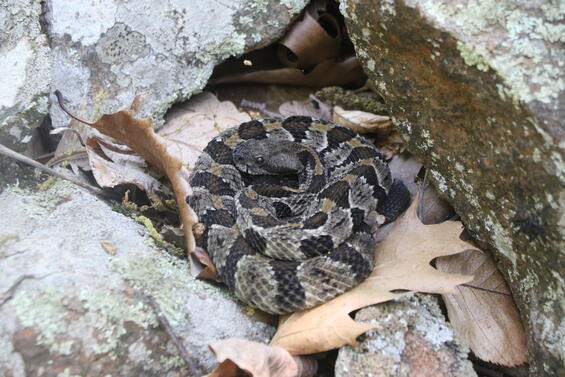
Juvenile timber rattlesnake from western Massachusetts.
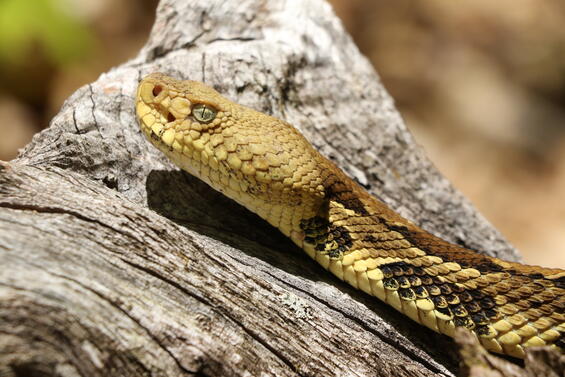
Yellow-phase adult timber rattlesnake from Massachusetts.
Conservation Action Plan
Adequately conserving the timber rattlesnake at the handful of sites where they occur in Massachusetts will require the active participation of key landowners and a multi-lateral approach, including the following strategies:
Habitat protection: Although the core areas of most known rattlesnake sites in Massachusetts are protected as conservation land, individual rattlesnakes often move out from core areas and are frequently found on private or municipal land. As it is for copperheads, it is important to strategically improve habitat connectivity between rattlesnake denning sites, including historic areas of occurrence, with surrounding habitats. Roads of any size—especially those within protected areas such as State Parks and State Reservations—pose an ongoing and persistent risk to individual rattlesnakes, and measures designed to mitigate road mortality are important, such as wildlife passage structures and/or seasonal road closures
Public education: It is clearly important to improve public understanding of rattlesnakes, which (along with copperheads) are among the most misunderstood vertebrates in Massachusetts. Sustained and thoughtful education programs by MassWildlife, MassDCR, and other key partners can reduce misconceptions and misidentification.
Minimizing human influence on montane habitats: Although controversial, it is important to limit new trail construction in timber rattlesnake habitat and to strategically retire existing trails. In some cases, it is appropriate to re-route or seasonally close existing trails that come close to rattlesnake dens or birthing areas.
Reducing negative interactions with people: Rattlesnakes are often killed by landowners, recreationists, and public safety officers (although any form of harassment is prohibited by state law, and the frequency of targeted killing is probably less today than it was several decades ago). It is important to reliably enforce existing legal protections for rattlesnakes when they are purposefully harassed or killed. It is also important to minimize all forms of disturbance to sensitive habitat features, by making efforts to reduce frequent visits by curiosity-seekers, land managers, and even researchers.
Collaborative conservation: Realistically, rattlesnake conservation in Massachusetts will require collaboration among state agencies such as MassWildlife and MassDCR and the Environmental Police, state and local law enforcement, conservation organizations such as the Nature Conservancy and MassAudubon, universities, key municipalities, recreation groups, and the public.
References
Bauder, J., A.G. Stengle, M.T. Jones, M. Marchand, D. Blodgett, B. Hess, B. Clifford, and C.L. Jenkins. 2018. Population demographics, monitoring, and population genetics of timber rattlesnakes in New England. Report to the Regional Conservation Needs (RCN) program. 308 pp.
Brown, W. 1991. Female reproductive ecology in a northern population of the timber rattlesnake, Crotalus horridus. Herpetologica 47:101–115.
Bushar LM, Bhatt N, Dunlop MC, Schocklin C, Malloy MA, Reinert HK. 2015. Population isolation and genetic subdivision of timber rattlesnakes (Crotalus horridus) in the New Jersey Pine Barrens. Herpetologica 71:203–211.
Clark AM, Moler PE, Possardt EE, Savitzky AH, Brown WS, Bowen BW. 2003. Phylogeography of the timber rattlesnake (Crotalus horridus) based on mtDNA sequences. Journal of Herpetology 37:145–154.
DeGraaf, R.M., and M. Yamasaki. 2001. New England Wildlife: Habitat, Natural History, and Distribution. University Press of New England. Hanover, N.H.
Reinert, H., and R. Zappalorti. 1988. Timber rattlesnakes (Crotalus horridus) of the pine barrens: Their movement patterns and habitat preference. Copeia 1988(4): 964–978.
Reinert, H., and R. Zappalorti. 1988. Field observation of the association of adult and neonatal Timber rattlesnakes (Crotalus horridus) with possible evidence for conspecific trailing. Copeia 1988(4): 10571059.
Stengle AG. 2017. Habitat selection, connectivity, and population genetics of a timber rattlesnakes (Crotalus horridus) metapopulation in southwestern Massachusetts, New England. University of Massachusetts, Amherst, Massachusetts.
Tyning, T.F. 1990. A Guide to Amphibians and Reptiles. Boston: Little, Brown and Company.
University of Massachusetts. 2009. Snakes of Massachusetts. UMass Extension, College of Natural Sciences. http://www.masnakes.org/guide.html.
Contact
| Date published: | April 1, 2025 |
|---|